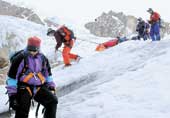 |
| MIND IT: Whether in a group or moving alone, make sure you do not leave out some essential stuff |
Come rain, slush or swamps ? you cannot shut out the call of the wild, the desert or the mountains. So you are ready with your backpack, all your nicks and nacks in tow. But are you aware of the ways to protect your maps from the rain? Or how to keep yourself clean while covering stretches where there is limited water? If you want to have fewer hassles on the trip, then read on.
Save your map
It?s no fun trying to navigate while clinging to your soggy map in a downpour. Right before you eyes, the route home begins to turn into a brownish-green clump. So instead of relying on your memory to substitute for the washed-out map, try out some waterproofing. Cover your map with some clear contact paper, making the map waterproof and stiff. You cannot write on the map with a pencil now. Instead, use an indelible ink marker to highlight your route and make notes. The marker lines can be removed with a gauze pad soaked in spirit. Check out some map and outdoor specialty stores for any chemical coating for maps. This will keep the map waterproof, flexible and able to be written on.
wipe it clean
It?s not an easy task to ?clean? yourself when desert or winter camping. Use an absorbent towel and a ?no rinse? soap to clean yourself. There are a few brands of ?no lather? and ?no rinse? soaps and body shampoos in the market. But your towel?s going to get very dirty, as the dirt has to go somewhere. But for the one or two cleanings you may desire, one towel should suffice. Another tried and tested method of cleaning involves turning to baby wipes. You need a couple of these to clean your face and another two to do your body. The downside is that you have carry home all the used wipes and the fragrance often used in the wipes can become a bit too much for your nose.
water basics
You can use a small wash pan for laundry and sponge bathing. But please keep soap out of rivers, lakes and other water sources. Dump all waste at least a 100 feet from any water. Do all your pot scrubbing and washing well back from the shore.
mind the litter
If you can pack in, you can pack out as well. So don?t leave any thing behind, even forgotten laundry is litter when you are camping. Place all your litter and solid waste in a garbage for later disposal. Place the garbage bag inside a stronger bag. Keep this bag accessible, so you can pick up litter along the way. Even food waste should be deposited in the bag. Take cans, bottles, wrappers, cigarette butts, etc. with you when you leave the site.
Think of the animals and the surroundings if you still decide to leave behind a trail of litter. Small animals such as raccoons can get their paws caught or cut in empty food cans. Discarded film packs often contain toxic chemicals that can be poisonous to deer or other animals that eat them.
food for thought
Keep fuel and insecticides away from food storage and preparation; keep them in a separate container. Be sure all food that is perishable is fresh and purchased just before your trip. Prepare food at home and package it, so camping won?t be such a chore. Zip-lock bags help in keeping food dry. Use recipes that better adapt to cooking outdoors. For such recipes just go over to your nearest bookstore.
the basic stuff
Whether in a group or moving alone, make sure you do not leave out some essential stuff. These are: a first-aid kit, map and compass, extra flashlight with a set of fresh batteries, waterproof matches, extra throw bag, duct tape, ropes, medicines, and energy-giving foods (apart from your staple food) like chocolates, munchies, etc.











